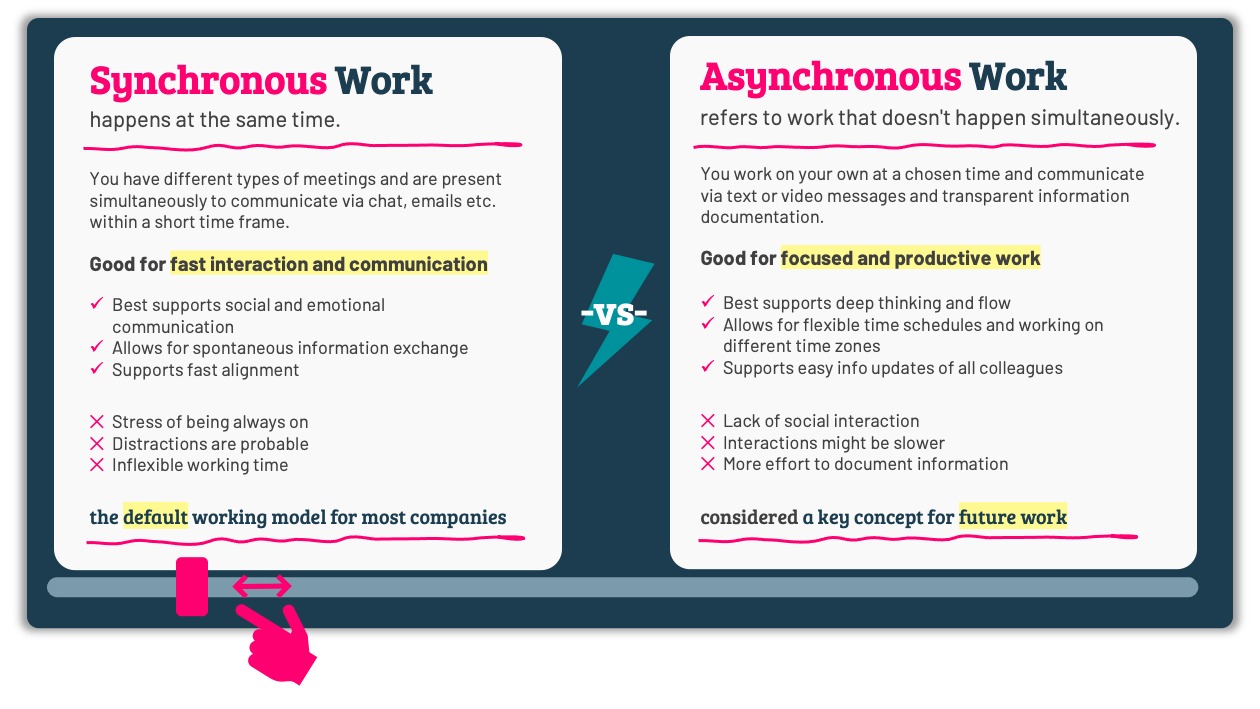Tips on how to start async work
and an inconvenient truth
Async work is not just the one thing or the one hack.
Usage of new tools or existing tools differently
Methods and skills to work differently
Change of behavior
and of rules
Problems with synchronous work
The currently observable meeting mania comes in these four flavors
There are too many dependencies on other co-workers
Prioritizing synchronous work over asynchronous work,
produces often bad quality due to
We often feel guilty in our work life because
Advantages of asynchronous work
Tips on how to start on your own
1. Check your information-sharing behavior in meetings
One misuse of synchronous time in meetings is often information sharing. Much information is better shared in front of or perhaps afterward. This must not be true for every piece of information.
So here is the advice:
Observe
After every coming meeting observe whether the information was shared and if it might better be shared before or afterward. Put yourself a marker in your calendar or a reminder in your notebook to remind it after *every* meeting.
Analyze your own behavior
At which of the meetings did you share information, that could perhaps be documented and shared otherwise?
Try to change
Take one opportunity to try out new information sharing. Take the time to write something down and send it over to the participants beforehand. Yes, this seems to be more work. But it might be worth it because,
So here is the advice:
Observe
After every coming meeting observe whether the information was shared and if it might better be shared before or afterward. Put yourself a marker in your calendar or a reminder in your notebook to remind it after *every* meeting.
Analyze your own behavior
At which of the meetings did you share information, that could perhaps be documented and shared otherwise?
Try to change
Take one opportunity to try out new information sharing. Take the time to write something down and send it over to the participants beforehand. Yes, this seems to be more work. But it might be worth it because,
- You prepare the information much clearer and concise
- As often people are missed in meetings, you can reach them effectively and efficiently.
- Questions are much better, and discussions about your topic are deeper because everyone could think it through already. The chance to reach your goal is higher.
2. Use rich communication and collaboration tools.
Complex topics are challenging to explain by writing them down. Often, you want to show something, or telling is much faster and easier. That is why we usually prefer to schedule a meeting.
But wait. Isn't it possible to record you screen and your voice to accomplish the same goal? You would send it before the meeting and everyone would watch it at their preferred time. In the meeting, you can jump right into the topic and start the discussion, because everyone is already prepared.
But wait. Isn't it possible to record you screen and your voice to accomplish the same goal? You would send it before the meeting and everyone would watch it at their preferred time. In the meeting, you can jump right into the topic and start the discussion, because everyone is already prepared.
There can be several reasons, why you might think, you cannot record a screencast on your own. Here are these, that we hear most often:
In reality, you most probably have all the hardware and software on your computer if you ever participated in a video meeting, have Microsoft Powerpoint installed on your computer or have access to free software on the internet.
The effort to record a screencast is similar to explaining a topic to a co-worker in a meeting. At first, you are not used to it, but after the third or fourth try, it is getting easier.
To adjust your expectation on professional results: The screencast will be as professional as your performance in every other meeting. Recording screencasts is not about producing high glossy results. You are just talking to your co-workers and explaining to them some facts. As soon as you realize this, it will become easy to record your first screencast.
- I don't have the hardware, software and technical skills
- It's much effort to record a video
- I don't think I can achieve professional results
In reality, you most probably have all the hardware and software on your computer if you ever participated in a video meeting, have Microsoft Powerpoint installed on your computer or have access to free software on the internet.
The effort to record a screencast is similar to explaining a topic to a co-worker in a meeting. At first, you are not used to it, but after the third or fourth try, it is getting easier.
To adjust your expectation on professional results: The screencast will be as professional as your performance in every other meeting. Recording screencasts is not about producing high glossy results. You are just talking to your co-workers and explaining to them some facts. As soon as you realize this, it will become easy to record your first screencast.
So here is the advice: Try it out. The next time you want to share information in a meeting, think about taking a small screencast and sending it over to your colleagues.
3. Establish distraction-free zones
To get things done, it's important to have larger junks of distraction-free time.
Here is how you can start:
Here is how you can start:
Search for a time in your calendar that can be blocked.
At first, search for just one block of two or three hours in every of the next two weeks. Rearrange meetings if needed.
You now have an important meeting at this time.
You don't need to tell others, that it's a meeting with yourself. Defend this important meeting against every other meeting request. Make clear beforehand that you cannot be disturbed in this meeting.
Use this distraction-free time for an important task.
Don't set too large expectations on it. The first meeting with yourself might be free time to research something you ever wanted. Enjoy!
At first, search for just one block of two or three hours in every of the next two weeks. Rearrange meetings if needed.
You now have an important meeting at this time.
You don't need to tell others, that it's a meeting with yourself. Defend this important meeting against every other meeting request. Make clear beforehand that you cannot be disturbed in this meeting.
Use this distraction-free time for an important task.
Don't set too large expectations on it. The first meeting with yourself might be free time to research something you ever wanted. Enjoy!
One inconvenient truth
Think of your last try to go to the gym or eat less sweets in your personal life. A long lasting change is difficult to apply. At work, it is not different or even harder.
Even, if you would have changed your own work habits and are highly successful, your work depends on the behavior of your co-workers. When they don't change their habits, you most likely will fall back to old working styles.
What to do?
2
Reach out for a commitment to change your work habits in a joint effort
4
Establish checkpoints and correct your direction
This is how we may help you
Raise awareness in your team
To raise awareness among your co-workers, send them a link to the async starter information, you already read and let them go through the process. It is always good to have allies!
Assess your team's potential and create commitment
We have prepared a free team self-assessment, that will help to find out your team's potential. You and your co-worker can register for free. You will find some easy-to-answer questions and a guide on how to analyze and decide upon.
While your co-workers start to inform themselves, feel free to pre-register for this self-assessment yourself. It's fully free without any strings attached. In the self-assessment, you will find further instructions on how to onboard your team members and proceed.
Start a habit change program in your team
We will offer a 9-week program for your whole team to take you through the change process and give you individual coaching. This program will be an effective and efficient way to establish long-lasting async work habits in your group.
The course is still in development. Find some more information below.
We will inform you as soon as the program is available!
We will inform you as soon as the program is available!
Async your team work
Learn how to change your working habits
as a whole team using asynchronous methods
as a whole team using asynchronous methods
Assess your team potential with easy to answer questions
Get easy-to-apply tips and hacks for better team collaboration
Go on a team journey with a step-by-step guidance to change your habits together
Become more productive together and get back your flexibility at work and in your life
Write your awesome label here.


